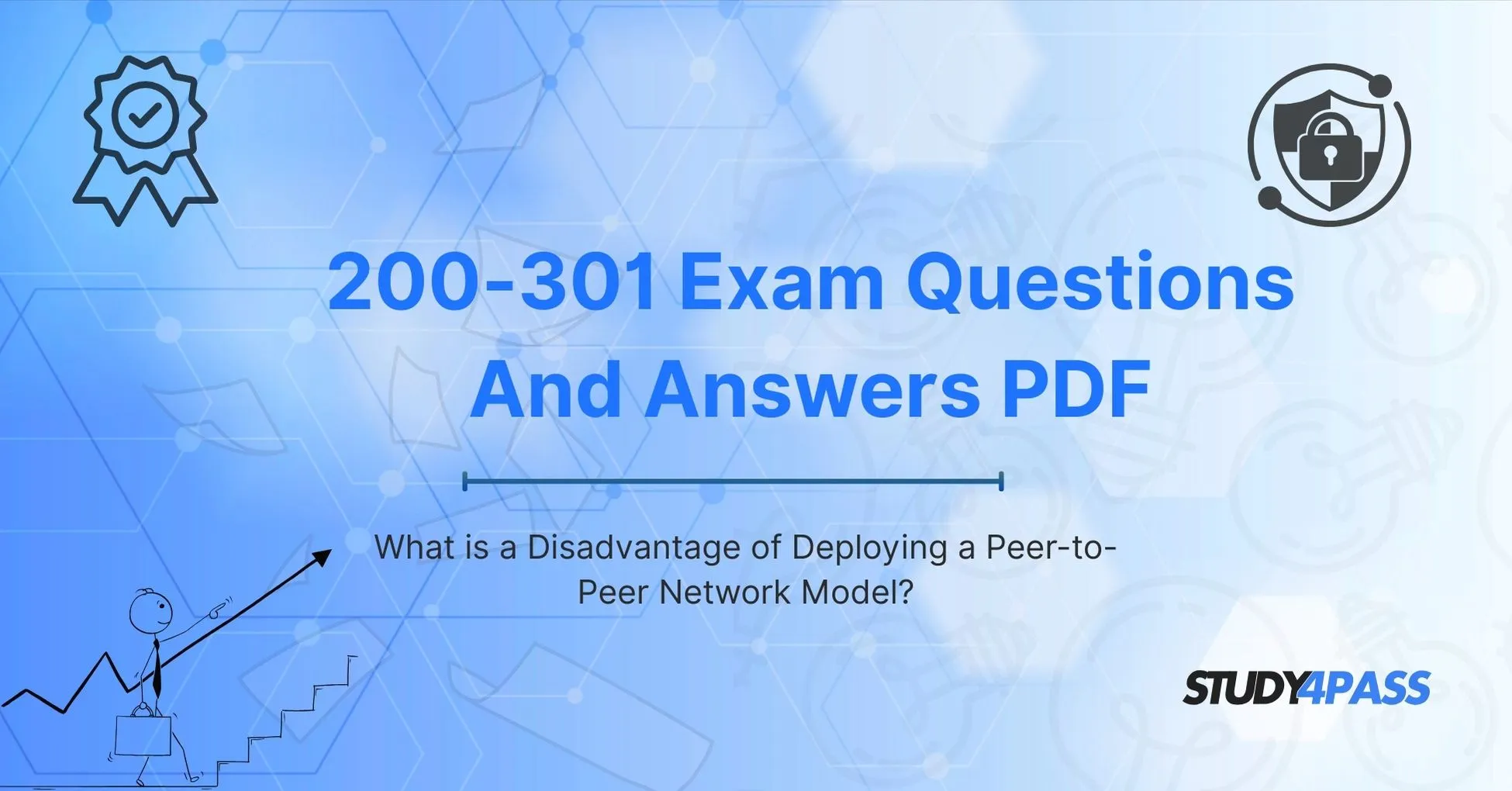Introduction To 200-301 Exam Questions And Answers PDF
In the world of networking, choosing the right network model is crucial for efficiency, security, and scalability. One common model is the peer-to-peer (P2P) network, where devices (peers) communicate directly without a central server. While P2P networks have advantages like cost-effectiveness and simplicity, they also come with significant drawbacks—especially for professionals preparing for the CCNA 200-301 exam.
If you're looking for reliable 200-301 exam questions and answers PDF resources to help you master networking concepts, Study4Pass offers comprehensive study materials to ensure your success.
In this blog, we’ll explore the disadvantages of deploying a peer-to-peer network model, helping you understand why it may not always be the best choice for enterprise environments.
What is a Peer-to-Peer (P2P) Network?
A peer-to-peer (P2P) network is a decentralized model where all connected devices (peers) have equal privileges and can function as both clients and servers. Unlike client-server networks, where a central server manages resources, P2P networks allow direct communication between devices.
Common Examples of P2P Networks:
- File-sharing platforms (BitTorrent, Napster)
- Blockchain networks (Bitcoin, Ethereum)
- Small office/home office (SOHO) networks
- While P2P networks are useful in some scenarios, they pose challenges in larger, more structured environments.
Disadvantages of Deploying a Peer-to-Peer Network Model
1. Lack of Centralized Security Management
One of the biggest drawbacks of P2P networks is the absence of centralized security controls. In a client-server model, security policies, firewalls, and access controls are managed from a central point. However, in P2P networks:
- Each device must enforce its own security measures.
- Malware or unauthorized access on one peer can spread easily.
- No centralized authentication (like Active Directory) makes user management difficult.
For IT professionals preparing for the 200-301 Certification, understanding network security is critical, and P2P networks often fail to meet enterprise security standards.
2. Poor Scalability
P2P networks work well in small environments but struggle with scalability. As more devices join:
- Network performance degrades due to increased traffic.
- Managing resources becomes complex without a central authority.
- Data consistency issues arise since files are stored across multiple peers.
For large organizations, a client-server model is more efficient, ensuring better resource management and performance—key topics in CCNA 200-301 exam questions and answers PDF guides.
3. Data Backup and Recovery Challenges
In a P2P network, data is distributed across multiple devices, making backup and recovery difficult:
- No centralized storage means critical files may be lost if a peer fails.
- Ensuring all peers have the latest version of a file is challenging.
- Disaster recovery is complex without a single point of control.
- For businesses requiring reliable data management, P2P networks are often inadequate.
4. Performance Issues
Since P2P networks rely on peer availability, performance can be inconsistent:
- If a peer with critical resources goes offline, others cannot access them.
- Network congestion increases as more peers share bandwidth.
- No load balancing leads to uneven resource distribution.
- For high-performance environments, a structured client-server or cloud-based network is preferable.
5. Difficult Network Monitoring and Troubleshooting
Without centralized logging and monitoring:
- Identifying network issues is harder since traffic is distributed.
- No single point for network analytics or performance tracking.
- Troubleshooting requires checking each peer individually.
- This inefficiency is a major reason why enterprises avoid P2P networks.
Why Study4Pass is the Best Choice for CCNA 200-301 Exam Prep
If you're preparing for the CCNA 200-301 Exam, understanding networking models like P2P is essential. Study4Pass provides:
- Updated 200-301 exam questions and answers PDF for thorough preparation.
- Detailed explanations of networking concepts, including P2P disadvantages.
- Practice tests that simulate real exam scenarios.
With Study4Pass, you gain the knowledge and confidence to pass your CCNA exam on the first attempt!
Conclusion
While peer-to-peer networks offer simplicity and cost savings, their lack of centralized security, poor scalability, data management issues, performance bottlenecks, and troubleshooting difficulties make them unsuitable for large-scale deployments.
Special Discount: Offer Valid For Limited Time “Cisco 200-301 Exam Prep Practice Tests”
Actual exam question from Cisco's 200-301 Exam.
Sample Questions for Cisco 200-301 Exam Prep Practice Tests
Which of the following topics are typically covered in a 200-301 exam questions and answers PDF?
A. Video editing techniques and multimedia streaming
B. Network fundamentals, IP connectivity, and security fundamentals
C. Graphic design theory and UX/UI best practices
D. Mobile app development using Android Studio
What is a key advantage of using a verified 200-301 exam PDF from Study4Pass?
A. It eliminates the need for hands-on labs
B. It guarantees a passing score without studying
C. It offers organized content mapped to Cisco’s official exam blueprint
D. It provides access to proprietary Cisco routers
Which of the following best describes the purpose of downloading a “200-301 exam questions and answers PDF” from Study4Pass?
A. To gain direct access to Cisco's proprietary internal documentation
B. To preview obsolete networking standards and technologies
C. To study real-world practice questions aligned with current exam objectives
D. To automatically register for the Cisco 200-301 exam


